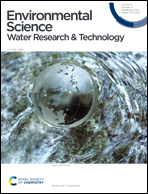Characterization of the nitrogen-transforming microbial community in the biofilms of a full-scale rotating biological contactor system treating wastewater from a fresh market building†
Abstract
In this study, the microbial community contributing to nitrogen-transforming processes was investigated in a rotating biological contactor (RBC) system treating wastewater from a fresh market building. Insights into core nitrogen-transforming microorganisms in the RBC biofilms were explored through a quantitative PCR approach and high-throughput sequencing of 16S rRNA and the nitrogen functional genes (e.g., amoA, NxrB, NxrA, and narG). A high abundance of autotrophic ammonia-oxidizing bacteria (AOB) and anaerobic ammonia oxidizing (anammox) bacteria (Candidatus Brocadia and Candidatus Anammoximicrobium) was detected in the RBC biofilms, suggesting their roles in aerobic and anaerobic ammonia oxidation, respectively. Heterotrophic AOB, ammonia-oxidizing archaea (AOA), and complete ammonia oxidation (comammox) bacteria were detected at relatively low abundance. High numbers of Nitrospira suggested that nitrite oxidation was also a crucial nitrogen-transforming pathway in these RBC biofilms. Together with common denitrifying bacteria, partial denitrifiers (Thiobacillus, Thauera, Terrimonas, and Flavobacterium) were also detected in the biofilms. Our data reveal the co-occurrence of nitrogen-transforming microorganisms with broad ranges of substrate affinities, which likely accounts for the performance and stability of the RBC system. Based on the nitrogen-transforming microorganisms identified here, it is proposed that partial nitrification/anammox, nitrification/partial denitrification/anammox, or both pathways are crucial for nitrogen-removal in RBC biofilms (besides the conventional nitrification–denitrification). Thus, RBCs might be useful for promoting ‘shortcut’ nitrogen removal as an energy-efficient system for treating medium-strength wastewater.



 Please wait while we load your content...
Please wait while we load your content...